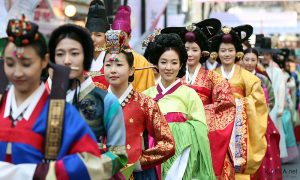Although clashes over cultural appropriation have seriously damaged relations between South Korea and China, foreign policy observers in Washington have stayed largely silent on the issue. This partly reflects the underrepresentation of historians and cultural experts in the U.S. capital, and it may soon prove to be a liability in Washington’s capacity to gauge and respond to the geopolitical climate in East Asia.
While outside observers might dismiss controversies like the one on the origins of Korean traditional dress as outbursts of petty nationalism, they are part of Beijing’s efforts to frame East Asia as an inviolable part of the Sinocentric sphere to both domestic and international audiences. And given Russia’s use of history to justify its invasion of Ukraine, the U.S. foreign policy establishment ignores these identity issues at the peril of Washington’s ability to stay ahead of developments in the region.
Princeton University Professor Gilbert Rozman observed that South Korea faces particularly severe attacks on its identity from China, which seeks to assert the view that there is something inherently wrong with Seoul’s autonomous foreign policy and, by extension, its ties to the United States. The belief that Seoul is being “insubordinate” previously underpinned Beijing’s aggressive, albeit unofficial, response to South Korea’s decision to host a U.S. missile defense system in 2016.
Rozman locates Beijing’s view that Seoul belongs in a subordinate position vis-a-vis China in the history of premodern tributary relationships, such as the one that existed between the Korean Joseon kingdom and the Chinese Qing dynasty.
But this history is complex and multifaceted. While not purely ritualistic, like the Portuguese submission of tribute to Chinese emperors for commercial privileges, political actors in Joseon frequently instrumentalized the relationship with China to advance their own domestic interests. This brings into question the extent to which the relationship was performative versus a social reality. For instance, many Joseon monarchs reigned without first receiving formal confirmation from the imperial court in Beijing, as was nominally appropriate in a tributary relationship.
A similarly complex relationship existed between China and Vietnam, where sovereigns of the Nguyen dynasty corresponded with the Chinese emperor as “kings” but referred to themselves as “emperors” domestically and maintained their own separate suzerainty over neighboring countries in the region.
Research by Jeeye Song at the University of Florida adds that later Qing efforts to formalize a subordinate relationship with Korea through unequal treaties based on the examples set by Western colonial powers were unsuccessful. The Korean government, meanwhile, asserted its sovereignty by establishing its own independent diplomatic representation abroad, starting with the legation in Washington D.C. in 1888.
Historical interpretation became a conscious and active part of China’s diplomacy in direct response to the collapse of its international prestige. Unable to project real power in the face of setbacks ranging from the defeat in the first Sino-Japanese War in 1895 to the civil war between warlords after the Xinhai Revolution, the Chinese Republic at the start of the 20th century pursued a new diplomatic strategy. According to Oxford lecturer Yuan Yi Zhu, the Chinese representatives at the 1919 Versailles Conference argued that China should be recognized as a great power based on the merit of its geographic size, cultural contribution, and historic role as suzerain over East Asia.
Western powers responded favorably to this line of argument (perhaps because Chinese diplomats lent rhetorical support to “peer” great powers’ real suzerainty over the Global South), setting the foundation of how successive Chinese governments would present themselves. This includes, as Zhu will emphasize in his forthcoming research, the Chinese Communist Party. In effect, Beijing still sees its great power status as partly contingent on the continuity of its historic role as regional hegemon.
In this context, the dispute over cultural appropriation between Korea and China takes on a threatening tone. Beijing’s insistence, for instance, that the ancient Korean kingdom of Goguryeo is part of Chinese history is less about being inclusive of the ethnic Korean minority in China and more about asserting the view that the Republic of Korea is not a fully legitimate country deserving respect or sovereignty. Similarly, Beijing insists Koreans cannot take ownership of their own traditional clothing because the Korean people do not have claim to an independent cultural identity. These narratives affirm a Sinocentric East Asian space.
Sharp responses from the South Korean public against China’s historical revisionism suggest that they intuitively recognize these moves as threats to their present-day sovereignty. But U.S. observers and influencers appear to sidestep conversations about the deeper implications of China’s claim to cultural and historical dominance in East Asia. This facilitates Beijing’s push to entrench a narrative that foreshadows retaliatory actions toward neighboring countries that infringe on its revisionist worldview.
The U.S. foreign policy establishment cannot ignore this undercurrent. But a response first requires discerning what is being stated in these narratives – a task for cultural experts and historians. Their views would greatly benefit Washington D.C. today.

































